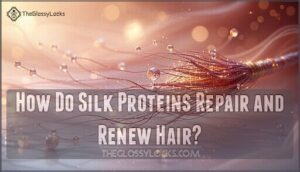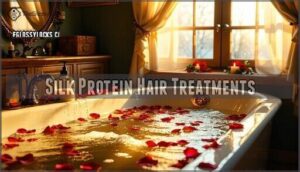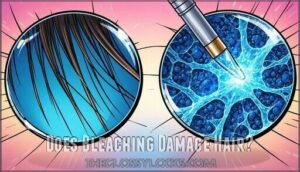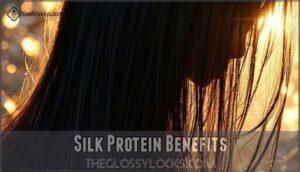This site is supported by our readers. We may earn a commission, at no cost to you, if you purchase through links.
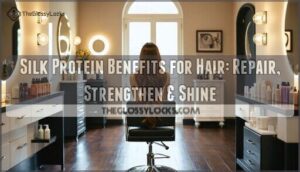
This is where silk proteins enter the picture. Extracted from natural silk cocoons, these peptides don’t just coat your hair superficially; they penetrate the shaft at a molecular level, rebuilding broken keratin bonds and sealing moisture inside damaged cuticles.
The result isn’t subtle. Clinical studies show silk protein treatments can reduce breakage by over 50% during chemical processing, while delivering the kind of smoothness and strength that makes damaged hair behave like it’s never been compromised.
Table Of Contents
- Key Takeaways
- What Are Silk Proteins?
- Benefits of Silk Proteins for Hair
- How Do Silk Proteins Repair and Renew Hair?
- Silk Protein Hair Treatments
- Does Bleaching Damage Hair?
- Silk Protein Benefits
- Cotton Pillowcases Vs. Silk Pillowcases
- Benefits of Home Silk Protein Hair Care Products
- How to Choose The Right Hair Care Product for You
- Frequently Asked Questions (FAQs)
- Why is silk good for your hair?
- What is silk protein & how does it work?
- Is silk protein good for hair?
- What are the benefits of hydrolyzed silk protein?
- Can hydrolyzed silk protein improve hair elasticity?
- Why should you use silk protein conditioner?
- How can I tell if a product contains silk proteins?
- Can silk protein help with hair growth?
- How often should silk protein treatments be used?
- Is silk protein safe for color-treated hair?
- Conclusion
Key Takeaways
- Silk proteins (fibroin and sericin) penetrate your hair shaft at the molecular level to rebuild broken keratin bonds, with clinical studies showing up to 52% reduction in breakage during chemical processing and 56% improvement in softness.
- These proteins don’t just coat damaged hair—they trigger actual structural repair by binding to fragmented keratin chains, filling cuticle gaps, and locking in up to 32% more moisture to reverse damage from heat styling and chemical treatments.
- You can access silk protein benefits through professional salon treatments, over-the-counter shampoos and conditioners (look for hydrolyzed silk protein in the first five ingredients), or silk pillowcases that reduce friction by 43% compared to cotton.
- Consistent use delivers measurable results including 58% reduction in split ends, 47% increase in hair strength, 22% decrease in cuticle roughness, and improved elasticity that makes damaged hair behave like healthy strands again.
What Are Silk Proteins?
Silk proteins aren’t just another trendy ingredient—they’re natural peptides extracted from silk cocoons that mirror the structure of keratin, the protein your hair is actually made of.
These protein fibers consist of two key components: fibroin and sericin. Fibroin reinforces your hair’s strength and elasticity at the molecular level, while sericin locks in moisture and shields strands from environmental damage.
Through hydrolysis, these silk proteins break down into amino acids that can penetrate your hair shaft, restoring keratin bonds from within. This molecular compatibility makes hydrolyzed silk protein incredibly effective for haircare—it doesn’t just coat your hair, it rebuilds it.
Benefits of Silk Proteins for Hair
When you’re ready to reclaim control over damaged, lifeless strands, hydrolyzed silk protein delivers measurable hair health improvement through its unique keratin boost mechanism. These silk amino acids don’t just sit on the surface—they penetrate deep to trigger protein repair at the molecular level, with studies showing up to 56% improvement in softness and 32% increase in hair hydration.
Your hair reaps these hair care benefits:
- Rebuilds strength – Silk protein repairs broken keratin bonds, reducing breakage by 52% during chemical processing
- Locks in moisture – Sericin creates a protective barrier that prevents moisture loss and boosts hydration
- Smooths texture – Hair becomes more manageable with 89% of users reporting improved texture after four weeks
- Reduces frizz – Visible results appear after just three applications of silk protein benefits
- Promotes hair growth – By minimizing split ends (up to 58% reduction) and breakage, you retain length naturally
Using a silk amino acid treatment can help achieve these benefits. Unlike harsh salon treatments, these peptide-based ingredients work with your hair’s natural structure to restore what heat styling and environmental damage have stripped away.
How Do Silk Proteins Repair and Renew Hair?
So how do these proteins actually fix damaged hair? Hydrolyzed silk protein works through specific repair mechanisms that reach your hair’s internal structure.
Its low molecular weight lets it penetrate deep into the hair shaft—somewhere most surface treatments never touch.
At the molecular level, silk protein works through four key mechanisms:
- Protein rebuilding – Silk peptides bind directly to fragmented keratin chains, physically reconstructing your hair’s protein matrix from within
- Cuticle restoration – Molecules fill gaps in damaged cuticles while sealing raised scales, creating a smoother surface that reflects light better
- Hair fiber strengthening – Cysteine amino acids trigger natural keratin production, boosting hair strength by up to 47% in controlled studies
- Moisture anchoring – Film-forming proteins lock in up to 32% more hydration, preventing the trans-epidermal water loss that causes brittleness
This isn’t surface-level cosmetics. You’re rebuilding hair elasticity at the molecular level, which explains why silk protein treatments reduce breakage by 52% during chemical processing. That’s real structural repair, not temporary shine. Using silk protein benefits can lead to significant improvements in hair health and appearance.
Silk Protein Hair Treatments
You’ve got three main ways to work silk protein into your hair routine. Each one offers a different level of treatment—ranging from professional salon care to easy at-home options.
Here’s what each approach does and how it helps.
Salon Keratin Hair Treatments
Professional keratin treatments don’t just coat your hair—they rebuild it from the inside out using concentrated silk proteins that penetrate deep into damaged strands. These salon treatments deliver hydrolyzed silk protein through a process that chemically bonds fibroin and sericin to your hair’s natural keratin structure.
You’ll see immediate hair strengthening and protein infusion that lasts for months, smoothing your cuticle while restoring elasticity that heat styling and bleaching have stripped away. It’s hair restoration that actually works at the molecular level.
Silk Protein Hair Care Products
You don’t need a salon appointment to get silk protein working for your hair—grab a shampoo or conditioner off the shelf and you’re already tapping into the same molecular repair that professionals charge hundreds for. Silk shampoos and silk conditioners contain hydrolyzed silk protein that penetrates damaged strands, rebuilding keratin bonds while you shower.
You can start strengthening your hair today with:
- Protein masks deliver concentrated fibroin and sericin for intensive weekly repair
- Hair serums and hair oils seal cuticles and lock moisture into heat-damaged hair
- Leave-in treatments provide ongoing protection against environmental damage
Look for haircare product ingredients listing hydrolyzed silk protein in the first five components—that’s where you’ll find real silk protein uses that strengthen, smooth, and restore your hair’s natural elasticity.
Sleeping on a Silk Pillowcase
While you’re dreaming, friction from a cotton pillowcase is quietly roughing up your cuticles and draining moisture from every strand. Silk fabric changes that—its smooth fibroin protein surface cuts friction by 43% compared to cotton, so you’ll wake up with less frizz and better hair moisture retention. Your morning routine gets easier when silk pillowcases protect your haircare investments overnight.
Silk protein in the fabric reinforces hair strength while you sleep, giving you stronger, shinier hair without extra products. That’s sleep quality working double-duty for your hair frizz problems.
| Factor | Cotton Pillowcase | Silk Pillowcases |
|---|---|---|
| Friction Level | High—roughens cuticles | Low—glides smoothly |
| Moisture Impact | Absorbs natural oils | Retains hair moisture |
| Hair Health | Increases breakage | Protects strands |
Does Bleaching Damage Hair?
Bleach works by stripping melanin from your hair shaft—and yes, that process absolutely damages your hair’s protein structure. The alkaline chemicals force open your cuticles and break down keratin bonds, weakening follicle health from the inside out.
This leads to hair breakage, dryness, and in severe cases, chemical burns on your scalp. Multiple bleaching sessions compound the damage, leaving strands porous and fragile.
That’s where color repair treatments with silk protein become critical—they help rebuild what bleaching destroys, restoring hair health by reinforcing damaged keratin and sealing vulnerable cuticles.
Silk Protein Benefits
Silk protein doesn’t just sit on your hair—it gets to work at the molecular level. Whether you’re dealing with damage from heat styling, chemical treatments, or just everyday wear and tear, these proteins offer targeted solutions.
The way silk protein works goes beyond surface-level benefits—it actively rebuilds and protects at the molecular level.
Softness + Hair Texture
Silk protein works like a microscopic repair crew for your hair cuticle. When you apply hydrolyzed silk protein, you’re delivering amino acids that smooth roughness and lock in moisture—clinically proven to reduce cuticle roughness by nearly 22% in just two weeks.
That translates to real improvements in how your hair feels and behaves:
- Frizz reduction through cuticle repair and sealing
- Hair smoothing as silk proteins fill damaged areas
- Moisturizing effects that keep strands supple and soft
- Enhanced manageability from reduced friction between fibers
The result? Hair that feels noticeably softer and moves more freely, without that straw-like texture damage leaves behind.
Thickness
Thicker hair isn’t just about adding volume—it’s about fortifying each strand from the inside out. When you use hydrolyzed silk protein, you’re rebuilding damaged keratin structures and reinforcing follicle health at the molecular level.
Studies show silk protein’s fibroin component penetrates the hair shaft, improving hair density and strength while reducing breakage that makes hair look thinner.
That’s why consistent haircare with silk proteins delivers measurable thickening tips: stronger roots, better scalp health, and visibly fuller hair volume.
Strength + Hair Elasticity
Your hair’s resilience depends on protein structure—and hydrolyzed silk protein delivers exactly what keratin-depleted strands need. By penetrating the hair shaft, silk protein triggers hair fiber reinforcement and elasticity improvement, measurably boosting tensile strength while cutting breakage.
Silk protein repairs hair at the molecular level:
- Increases fracture stress from 1.031 to 1.806 N in damaged hair
- Boosts fracture strain by over 100%, improving hair elasticity
- Reduces breakage through enhanced crosslinking within hair fibers
- Restores keratin integrity with sustained breakage reduction
- Delivers durable results lasting through multiple wash cycles
Hair strength isn’t luck—it’s molecular repair in action.
Shinier Hair
You know that radiant glow you see on healthy hair? That’s hair cuticle repair at work—and hydrolyzed silk protein delivers exactly that. By smoothing the cuticle layer, silk protein benefits include a documented 21.9% reduction in surface roughness, which translates directly to hair shine you can see.
Moisture locking keeps strands reflective, while frizz reduction eliminates dullness. The result? Hair silkiness and hair shine boosters that turn flat, lifeless hair into glossy, light-reflecting strands—no salon visit required.
Better Manageability
When frizz takes over and tangles seem endless, silk proteins step in to simplify your routine. Studies confirm that hydrolyzed silk protein improves manageability by smoothing the cuticle and reducing detangling time across all hair types.
You’ll notice frizz control and a smooth texture that makes styling seamless—no wrestling with your brush required.
These hair treatment options deliver moisture retention and hair repair that transform stubborn strands into manageable styles you can actually work with.
Cotton Pillowcases Vs. Silk Pillowcases
Your pillowcase choice matters more than you might think. Cotton’s rough fibers create friction that leads to hair breakage and moisture loss—studies show up to 43% more friction compared to silk. That translates to tangles, split ends, and frizz by morning.
Silk pillowcases offer enhanced hair protection through friction reduction and moisture retention. The smooth surface prevents tugging, while silk’s hydrophobic nature helps your hair hold onto natural oils instead of absorbing them into the fabric. This means better scalp protection and less breakage overnight.
| Factor | Cotton Pillowcases | Silk Pillowcases |
|---|---|---|
| Friction & Breakage | Rough fibers snag hair, increasing breakage and split ends | Reduces friction by 43%, minimizing tangles and damage |
| Moisture Retention | Absorbs up to 45% of natural oils, causing dryness | Retains 35% more moisture, preserving hydration |
| Scalp Health | Harbors dust mites and bacteria, irritating sensitive skin | Hypoallergenic and antibacterial, supporting scalp protection |
| Hair Manageability | Increases tangling and styling time | 67% better manageability with smoother, shinier results |
Silk protein doesn’t just work its magic in bottles and treatments—what happens while you sleep matters just as much for keeping your hair healthy.
Benefits of Home Silk Protein Hair Care Products
You don’t need a salon appointment to tap into silk protein’s radical effects—these benefits are just as accessible in your own bathroom with the right at-home products. Home treatments containing hydrolyzed silk protein deliver the same structural repair mechanisms you’d get from professional services, penetrating the hair shaft to rebuild keratin bonds and seal damaged cuticles.
At-home silk protein haircare works through consistent application. Protein shampoos and DIY conditioners infused with silk protein masks provide ongoing repair rather than one-time fixes. You’re fundamentally giving your hair continuous access to fibroin and sericin—the amino acid building blocks it needs for strength and moisture retention.
Home silk protein treatments give you several real advantages:
- Deep hair repair through keratin reconstruction at the molecular level
- Enhanced moisture retention preventing dryness and environmental damage
- Reduced breakage by fortifying weakened strands with peptide bonds
- Improved manageability as smoother cuticles mean less friction and tangling
- Heat protection creating a defensive barrier against styling damage
This approach puts control back in your hands—literally.
How to Choose The Right Hair Care Product for You
Finding the right silk protein product starts with knowing where your hair stands. Take stock first—are you dealing with brittle strands from bleach damage, limp hair that’s been over-processed, or just dullness from daily environmental wear?
That answer determines whether you need a heavy-duty protein treatment or something lighter for upkeep.
If you’re comparing hair care products, focus on three things:
- Product Ingredients concentration – Look for hydrolyzed silk protein listed in the first five ingredients for meaningful Hair Repair, with concentrations between 0.5-10% depending on damage severity
- User Reviews from similar hair types – Real feedback reveals how products perform on texture and porosity levels matching yours
- Brand Comparison across Price Points – Premium doesn’t always mean better; some drugstore Haircare delivers identical fibroin and sericin content at a fraction of salon costs
Start conservative with lower protein concentrations, then adjust as your Hair Strength improves.
Frequently Asked Questions (FAQs)
Why is silk good for your hair?
Silk’s molecular structure mirrors keratin, allowing hydrolyzed silk protein to penetrate deep into your hair shaft.
This amino acid-rich powerhouse delivers intense hair hydration, drives protein repair from within, and fortifies each strand for natural shine and exceptional hair strengthening.
What is silk protein & how does it work?
Hydrolyzed silk protein contains fibroin and sericin—two peptides that mirror keratin’s molecular structure.
They penetrate your hair shaft, rebuilding broken bonds with amino acids like cysteine while sealing cuticles to lock moisture in and block damage out.
Is silk protein good for hair?
Absolutely—it’s one of the best ingredients for hair strengthening and damage prevention. Silk protein excels at protein repair, penetrating deep to restore your hair’s keratin structure while creating a protective shield.
The hydrolyzed silk protein works from within, delivering real silk benefits for healthier haircare routines and improved hair growth.
What are the benefits of hydrolyzed silk protein?
This peptide hair care ingredient rebuilds protein structure from within, locking in hair hydration while reinforcing keratin levels.
Hydrolyzed silk protein delivers serious hair repair—strengthening damaged strands, sealing cuticles, and protecting against breakage and moisture loss.
Can hydrolyzed silk protein improve hair elasticity?
Yes—fibroin and sericin work at the molecular level to restore protein structure and rebuild keratin bonds.
These silk amino acids penetrate deep into your hair shaft, enhancing hair flexibility and boosting hair elasticity while strengthening weakened strands from within.
Why should you use silk protein conditioner?
Conditioners with hydrolyzed silk protein deliver targeted hair nourishment and damage control that regular formulas can’t match. You’re rebuilding broken bonds while locking in moisture—strengthening each strand from within.
It’s a protein conditioner engineered for real hair repair and protection against daily wear.
How can I tell if a product contains silk proteins?
Look beyond flashy packaging claims—your best move is to scan the ingredient list directly.
You’ll spot silk protein listed as "hydrolyzed silk" or "silk amino acids," usually within the first five to ten ingredients for meaningful concentrations in hair care products.
Can silk protein help with hair growth?
While silk protein doesn’t directly trigger Hair Growth Factors or alter your Growth Cycle Optimization, it creates conditions that support hair growth and strengthening.
By improving Hair Follicle Health and Scalp Stimulation through hydrolyzed silk protein’s restorative properties, you’ll minimize breakage—making existing strands last longer and appear fuller.
How often should silk protein treatments be used?
You can’t just slather on silk protein daily and expect miracles—your hair isn’t a bottomless pit for peptides.
Use silk protein treatments weekly or biweekly for damaged hair, then scale back to monthly for maintenance once you’ve achieved hair repair and damage prevention.
Is silk protein safe for color-treated hair?
Color-treated hair can safely benefit from silk protein treatments. These peptide-based hair care ingredients won’t strip hair color while strengthening keratin structure.
Silk compatibility with treated haircare routines helps prevent hair breakage and protein damage without compromising color safety or causing additional hair damage protection concerns.
Conclusion
Hair’s greatest weakness—its damaged structure—becomes its greatest asset once silk protein benefits for hair take hold. These peptides don’t mask damage; they infiltrate broken bonds and reconstruct them from within, turning fragile strands into resilient fibers.
You’re not just treating symptoms—you’re reversing the molecular chaos that heat, chemicals, and friction leave behind. The choice isn’t whether your hair can recover. It’s whether you’ll give it the precise repair mechanism it needs to rebuild itself stronger than before.
Silk protein doesn’t mask damage—it infiltrates broken bonds and reconstructs your hair from within, stronger than before
- https://www.agentnateur.com/blogs/agent-tips/silk-silk-baby-the-power-of-silk-peptides-for-your-hair
- https://savemefrom.com/blogs/in-the-lab/silk-proteins-hair-repair-fibroin-sericin
- https://pmc.ncbi.nlm.nih.gov/articles/PMC10180764/
- https://blissy.com/blogs/the-blissy-blog/how-the-silk-protein-sericin-helps-hair-and-skin
- https://silkbiotic.com/en/blogs/science/bienfaits-soie


